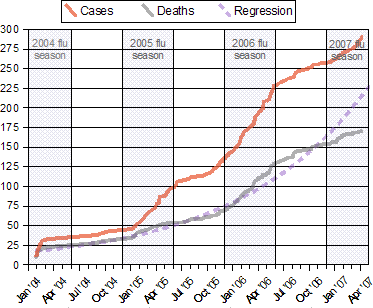It has been suggested that Global spread of H5N1 in 2004, Global spread of H5N1 in 2005, Global spread of H5N1 in 2006 and Global spread of H5N1 in 2007 be merged into this article. (Discuss) Proposed since September 2024. |
This article needs to be updated. (November 2022) |
This article is about an event or subject that may not be current but does not specify the time period. |
The global spread of H5N1 influenza in birds is considered a significant pandemic threat. While other H5N1 influenza strains are known, they are significantly different on a genetic level from a highly pathogenic, emergent strain of H5N1, which was able to achieve hitherto unprecedented global spread in 2008.[1] The H5N1 strain is a fast-mutating, highly pathogenic avian influenza virus (HPAI) found in multiple bird species. It is both epizootic (an epidemic in non-humans) and panzootic (a disease affecting animals of many species especially over a wide area). Unless otherwise indicated, "H5N1" in this timeline refers to the 2008 highly pathogenic strain of H5N1.
 Notes:
|
Tens of millions of birds have died of H5N1 influenza and hundreds of millions of birds have been slaughtered and disposed of, to limit the spread of H5N1. Countries that have reported one or more major highly pathogenic H5N1 outbreaks in birds (causing at least thousands but in some cases millions of dead birds) are (in order of first outbreak occurrence): South Korea, Vietnam, Japan, Thailand, Cambodia, Laos, Indonesia, China, Malaysia, Russia, Kazakhstan, Mongolia, Turkey, Romania, Croatia, Ukraine, Cyprus, Iraq, Nigeria, Egypt, India, France, Niger, Bosnia, Azerbaijan, Albania, Cameroon, Myanmar, Afghanistan, Israel, Pakistan, Jordan, Burkina Faso, Germany, Sudan, Ivory Coast, Djibouti, Hungary, United Kingdom, Kuwait, Bangladesh, Saudi Arabia, Ghana, Czech Republic, Togo, Nepal, Bhutan, the Philippines, and Chile.[2]
 |
Highly pathogenic H5N1 has been found in birds in the wild in numerous other countries: Austria, Bulgaria, Denmark, Greece, Iran, Italy, Poland, Serbia and Montenegro, Slovakia, Slovenia, Spain, Sweden, Switzerland, and Uruguay.[3] Surveillance of H5N1 in humans, poultry, wild birds, cats and other animals remains very weak in many parts of Asia and Africa. Much remains unknown about the exact extent of its spread.[citation needed]
H5N1 has low pathogenic varieties endemic in birds in North America. H5N1 has a highly pathogenic variety that is endemic in dozens of species of birds throughout south Asia and parts of Africa. So far, it is very difficult for humans to become infected with H5N1. The presence of highly pathogenic (deadly) H5N1 around the world in both birds in the wild (swans, magpies, ducks, geese, pigeons, eagles, etc.) and in chickens and turkeys on farms has been demonstrated in millions of cases with the virus isolate actually sequenced in hundreds of cases yielding definitive proof of the evolution of this strain of this subtype of the species Influenzavirus A (bird flu virus).[citation needed]
According to Robert G. Webster:
The epicenters of both the Asian influenza pandemic of 1957 and the Hong Kong influenza pandemic of 1968 were in Southeast Asia, and it is in this region that multiple clades of H5N1 influenza virus have already emerged. The Asian H5N1 virus was first detected in Guangdong Province, China, in 1996, when it killed some geese, but it received little attention until it spread through live-poultry markets in Hong Kong to humans in May 1997, killing 6 of 18 infected people. [...] From 1997 to May 2005, H5N1 viruses were largely confined to Southeast Asia, but after they had infected wild birds in Qinghai Lake, China, they rapidly spread westward. [...] The intermittent spread to humans will continue, and the virus will continue to evolve.Map[4]
On July 25, 2008, the Food and Agriculture Organization (FAO) released an Avian Influenza Disease Emergency Situation Update, reporting that H5N1 pathogenicity was continuing to gradually rise in endemic areas but the avian influenza disease situation in farmed birds was being held in check by vaccination. Eleven outbreaks of H5N1 were reported worldwide in June 2008 in five countries (China, Egypt, Indonesia, Pakistan and Vietnam) compared to 65 outbreaks in June 2006 and 55 in June 2007.[5]
- ^ "扬子晚报电子版". Archived from the original on October 7, 2008. Retrieved June 12, 2008.
- ^ "Chile detects first case of bird flu in a human". Reuters. March 29, 2023. Retrieved March 30, 2023.
- ^ "En Uruguay siguen apareciendo casos de gripe aviar". Diario El Comercial (in Spanish). March 15, 2023. Retrieved March 22, 2023.
- ^ Robert G. Webster; Elena A. Govorkova, M.D. (November 23, 2006). "H5N1 Influenza — Continuing Evolution and Spread". NEJM. 355 (21): 2174–2177. doi:10.1056/NEJMp068205. PMID 17124014.
- ^ "July 25, 2008 FAO Avian Influenza Disease Emergency Situation Update" (PDF). Archived from the original (PDF) on September 9, 2008. Retrieved August 18, 2008.
